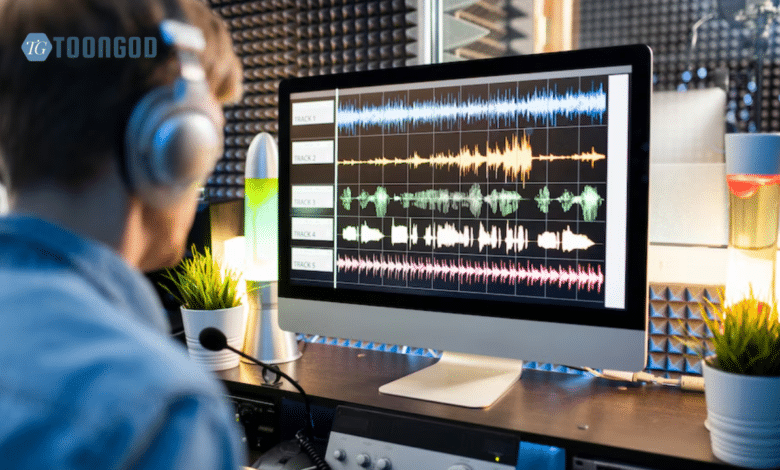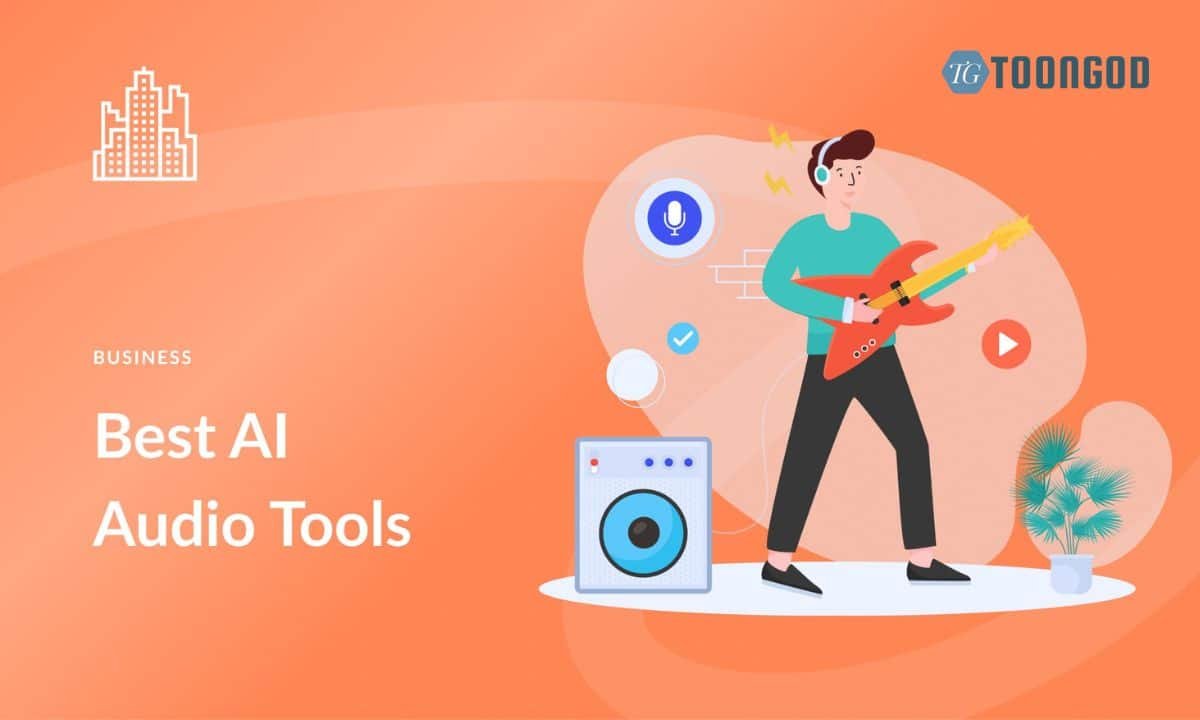Animation from Audio – The kingdom of voice with AI 2024

Animation from Audio: In the ever-evolving landscape of digital media, animation has emerged as a vital tool for storytelling, marketing, and education. Among the most innovative techniques in the animation field is animation from audio. This approach allows creators to transform audio elements into dynamic visual narratives, enhancing engagement and audience connection. In this comprehensive guide, we will explore the process of creating animation from audio, its applications, significance, and trends in the animation industry, particularly focusing on India and the United States in 2024.
Understanding Animation from Audio
Animation from audio is a creative process that uses audio clips—such as voiceovers, sound effects, and music—as the foundation for animated visuals. This technique synchronizes animated sequences with audio cues, enhancing the overall storytelling experience. By harnessing audio, animators can evoke emotions, convey messages, and create captivating narratives that resonate with viewers.
The Importance of Audio in Animation
The integration of audio in animation cannot be overstated. It plays a crucial role in adding depth to the visual experience. Audio enhances storytelling by establishing mood, tone, and pacing, which can significantly affect how the audience perceives the narrative.
When animators effectively harness the power of audio, they create more immersive and engaging content. In a digital world where attention spans are fleeting, compelling audio can capture viewer interest and keep them engaged. This is particularly relevant in the context of the animation industry in 2024, where audiences are continually seeking innovative and meaningful content.
The Process of Animation from Audio
Creating animation from audio involves a structured process that ensures the final product is engaging and effective. Here are the critical steps involved:
1. Scriptwriting
The first step in the animation process is developing a script based on the audio content. This script serves as a blueprint for the visual representation of the narrative. Whether it’s a podcast, dialogue, or a song, having a clear and compelling script is essential for effective animation.
In the scriptwriting phase, it’s important to consider the target audience and the key messages to be convey. This ensures that the narrative resonates with viewers and meets their expectations.
2. Audio Recording
Once the script is finalized, the next step involves recording the audio. This could be done using professional voice actors or through the use of high-quality sound recordings. The quality of the audio is critical, as it sets the foundation for the animation.
When recording audio, pay attention to the following factors:
- Clarity: Ensure that the audio is clear and free from background noise. This can be achieved by using quality microphones and soundproofing recording environments.
- Emotion: The tone and emotion of the voiceover should match the content of the animation. This can enhance viewer engagement and empathy.
- Timing: Be mindful of pacing. The timing of the audio should align with the intended visuals, providing a coherent flow to the animation.
3. Storyboarding
After the audio is ready, animators create storyboards to outline the visual sequences. Storyboarding is a crucial step as it helps in planning the flow of the animation and ensures that the visuals align with the audio.
A storyboard typically consists of sketches or illustrations that depict the key scenes in the animation, along with notes on audio cues. This serves as a visual reference for animators during the production phase.
4. Animation Production
With the storyboard as a guide, animators begin the production process. This stage involves creating characters, backgrounds, and visual effects that complement the audio. The production process requires creativity and technical skill, as animators must synchronize the visuals with the audio cues.
Here are some key considerations during the animation production phase:
- Character Design: The design of characters should reflect their personalities and roles within the narrative. Well-designed characters can enhance viewer connection and empathy.
- Backgrounds: Backgrounds set the scene for the animation. They should complement the characters and the narrative, providing context and depth.
- Visual Effects: Incorporating visual effects can enhance the animation’s appeal and make it more engaging. However, these should be used judiciously to avoid overwhelming the viewer.
5. Editing and Finalization
After the animation is produced, it undergoes editing to refine both the visuals and audio. This includes adjusting the timing, adding sound effects, and enhancing the overall quality. The final product should seamlessly integrate the audio and visuals, providing a cohesive viewing experience.
During the editing phase, consider the following aspects:
- Timing Adjustments: Ensure that the timing of the visuals matches the audio cues. This synchronization is essential for effective storytelling.
- Sound Effects: Adding sound effects can enhance the overall experience. These should be relevant and enhance the narrative without being distracting.
- Quality Control: Conduct thorough quality control to identify any inconsistencies or issues that need to be addressed before the final release.
Applications of Animation from Audio
The versatility of animation from audio allows it to be used in various fields. Here are some common applications:
1. Education and E-Learning
In the realm of education, animation from audio is a powerful tool for e-learning. It helps explain complex concepts in a visually appealing manner, making learning more engaging. Educators can create animated videos that incorporate audio explanations, enhancing students’ understanding and retention of information.
With the rise of online education, animated content has become increasingly popular. For instance, animated explainer videos can break down intricate subjects into digestible pieces, catering to various learning styles.
2. Marketing and Advertising
In the competitive landscape of marketing, businesses are constantly looking for innovative ways to capture their audience’s attention. Animation from audio can be an effective strategy for creating promotional content. By pairing catchy audio with vibrant animations, brands can convey their messages effectively and create memorable advertisements.
Brands like Nike and Coca-Cola have successfully used animated content to enhance their marketing campaigns. By incorporating audio elements, they create a more immersive experience that resonates with viewers.
3. Entertainment and Media
The entertainment industry has embraced animation from audio in various forms, such as animated series, music videos, and films. By synchronizing music and dialogue with animation, creators can produce captivating stories that entertain and engage viewers.
Popular animated series like “Rick and Morty” and “BoJack Horseman” utilize audio to enhance storytelling, using voiceovers to create character depth and humor.
4. Social Media Content
With the rise of social media platforms, animated content has become increasingly popular. Creators can use animation from audio to produce short, shareable videos that resonate with their audience. These videos can be used for storytelling, marketing, or simply for entertainment.
Platforms like TikTok and Instagram have seen a surge in animated content, where creators pair audio clips with engaging visuals. This format encourages sharing and can go viral quickly.
5. Podcasts and Audio Stories
Podcasts and audio stories are gaining traction, and many creators are now incorporating animations to enhance their audio content. By adding visuals to audio narratives, they can attract a wider audience and create a more immersive experience.
Animated podcasts, like “The Off-Camera Show,” combine engaging visuals with audio storytelling, making them appealing to a broader audience.
The Evolution of AI Audio
The journey of AI audio can be traced back to early research in sound synthesis and speech recognition. Over the years, significant advancements in machine learning and neural networks have propelled the field forward. Here are some key milestones in the evolution of AI audio:

1. Early Speech Recognition
In the 1950s and 1960s, researchers began experimenting with speech recognition systems, laying the groundwork for future developments in AI audio. Early systems relied on rule-based approaches, which limited their accuracy and versatility.
2. Emergence of Neural Networks
The introduction of neural networks in the 1980s and 1990s revolutionized audio processing. These models allowed for more sophisticated pattern recognition, enabling better speech recognition and sound synthesis.
3. Deep Learning Breakthroughs
The advent of deep learning in the 2010s marked a turning point for AI audio. Advanced algorithms, such as recurrent neural networks (RNNs) and convolutional neural networks (CNNs), significantly improved the quality of speech synthesis and music generation.
4. Realistic Voice Synthesis
Recent advancements in AI voice synthesis have enabled the creation of lifelike voices. Technologies like WaveNet, developed by DeepMind, have made it possible to generate human-like speech that is indistinguishable from real voices.
5. AI in Music Production
AI music generation tools, such as OpenAI’s MuseNet and Jukedeck, have gained popularity, allowing musicians and producers to experiment with new compositions and styles. These tools can analyze existing music to create original pieces based on user preferences.
Applications of AI Audio
AI audio is finding applications in various industries, significantly impacting how we create, consume, and interact with sound. Here are some key areas where AI audio is making a difference:
1. Music Production and Composition
AI tools are revolutionizing the music industry by streamlining the production process and aiding musicians in composing new tracks. AI algorithms can analyze existing music to identify trends, generate melodies, and even assist in arranging songs. This allows musicians to focus on creativity while leveraging technology for efficiency.
- AI-Powered DAWs: Digital Audio Workstations (DAWs) are integrating AI features that provide recommendations for arrangements, mix settings, and effects, enhancing the creative process.
2. Voice Assistants and Chatbots
AI audio is integral to the functionality of voice assistants like Amazon’s Alexa, Apple’s Siri, and Google Assistant. These systems rely on natural language processing (NLP) to understand user commands and respond with human-like voices. The continuous improvement of voice synthesis technology ensures that these interactions feel more natural and engaging.
3. Audiobooks and Podcasts
AI audio is transforming the audiobook and podcast industry by enabling the creation of realistic voiceovers for narrations. AI-generated voices can be customized to reflect different styles and tones, making audiobooks and podcasts more accessible and engaging for listeners.
- Voice Cloning: Voice cloning technologies allow authors or public figures to create personalized audio content using their voice, enhancing the authenticity of their narratives.
4. Gaming and Virtual Reality
In the gaming industry, AI audio is used to create immersive soundscapes and dynamic audio experiences. AI algorithms can generate sound effects and adapt audio in real time based on player interactions, enhancing realism and engagement.
- Adaptive Sound Design: AI-driven sound design tools analyze gameplay and adjust audio elements dynamically, providing players with a personalized experience.
The Significance of Animation from Audio in India and the US (2024)
As we look towards 2024, the significance of animation from audio is expected to grow, especially in India and the United States.
1. Growth of the Animation Industry
Both India and the US have vibrant animation industries that are continuously evolving. The demand for animated content is on the rise, driven by technological advancements and the increasing popularity of digital platforms. Animators who can effectively leverage animation from audio will be well-positioned to succeed in this competitive landscape.
In India, the animation industry has seen remarkable growth, with companies like Toonz Media Group and Green Gold Animation leading the way. The increasing use of animation in advertising, gaming, and education has contributed to this growth.
2. Cultural Exchange and Collaboration
In recent years, there has been a surge in collaboration between Indian and American animators. This cultural exchange has led to the fusion of styles and techniques, resulting in innovative content that resonates with diverse audiences. Animation from audio serves as a common ground for these collaborations, allowing creators to tell stories that reflect both cultures.
Collaboration projects, like the animated film “The Breadwinner,” produced by an American and Canadian studio with Indian animation talent, demonstrate the power of cultural exchange in the animation industry.
3. Advancements in Technology
Technological advancements in animation tools and software are making it easier for creators to produce high-quality content. In 2024, we can expect to see more user-friendly animation tools that enable even novice animators to create compelling visuals from audio. This democratization of animation will lead to an influx of diverse voices and stories in the industry.
Innovative tools like Adobe Animate, Toon Boom Harmony, and Blender are making it easier for creators to experiment with animation from audio, allowing them to bring their ideas to life.
4. Increased Focus on Mental Health and Well-being
In light of recent global events, there has been a growing emphasis on mental health and well-being. Animators are using animation from audio to create content that addresses mental health issues, promotes mindfulness, and fosters positive emotional experiences. This trend is likely to continue in 2024, as creators recognize the power of animation in addressing social issues.
For instance, animated series like “Big Mouth” tackle adolescent issues and mental health in a humorous yet relatable way, using audio to convey complex emotions.
Tips for Creating Effective Animation from Audio
If you’re interested in exploring animation from audio, here are some tips to help you get started:
1. Choose High-Quality Audio
The quality of your audio is crucial for creating effective animation. Invest in good recording equipment or hire professionals to ensure that your audio is clear and engaging. This will provide a solid foundation for your animation.
2. Keep It Simple
When creating animation from audio, simplicity is key. Focus on clear visuals that complement the audio without overwhelming the viewer. This will help convey your message effectively and maintain viewer engagement.
3. Sync Audio and Visuals
Ensure that your visuals are in sync with the audio. This synchronization enhances the viewing experience and reinforces the narrative. Use animation software that allows for precise timing adjustments.
4. Experiment with Styles
Don’t be afraid to experiment with different animation styles. Whether it’s 2D, 3D, or stop-motion animation, find a style that suits your audio content and resonates with your target audience.
5. Test and Gather Feedback
Before finalizing your animation, gather feedback from peers or potential viewers. Testing your content can help identify areas for improvement and ensure that your animation effectively conveys its intended message.
Trends in Animation from Audio for 2024
As we look forward to 2024, several trends in animation from audio are expected to shape the industry:
1. Interactive Animation
Interactive animation is gaining traction, allowing viewers to engage with the content actively. This trend is especially prominent in educational contexts, where animated lessons can include quizzes, interactive elements, and user-driven narratives. This enhances the learning experience and keeps viewers engaged.
2. Personalized Content
With advancements in artificial intelligence and machine learning, personalized content is becoming a reality. Animators can create tailored experiences based on user preferences, making the content more relevant and engaging. This trend is particularly important in marketing and advertising, where brands seek to connect with their audience on a personal level.
3. Sustainability in Animation
Sustainability is a growing concern across industries, including animation. Many creators are exploring eco-friendly practices, such as using sustainable materials in production and focusing on narratives that promote environmental awareness. This trend resonates with audiences who prioritize sustainability in their consumption choices.
4. Use of Virtual Reality (VR) and Augmented Reality (AR)
The integration of VR and AR technologies in animation is on the rise. These technologies offer immersive experiences that engage viewers in new ways. Creators are exploring the potential of animation from audio in virtual environments, allowing audiences to interact with the content in real-time.
5. Global Collaboration
As the animation industry continues to globalize, collaborations between creators from different regions are becoming more common. This trend leads to the fusion of diverse styles and storytelling techniques, resulting in unique and innovative content.
Conclusion
Animation from audio is a powerful technique that enhances storytelling in various fields, from education to entertainment. As we move into 2024, the significance of this approach will continue to grow, particularly in India and the United States. By embracing the fusion of audio and visuals, animators can create compelling narratives that resonate with audiences across cultures.
At Toongod, we are committed to exploring innovative animation techniques and sharing insights that inspire creativity. For more information about our journey in animation and our services, visit our About Us page. If you have any questions or wish to collaborate, feel free to reach out through our Contact Us page. Additionally, check out our post on Adobe Express Animation to discover more about animation tools and techniques. Let’s embrace the power of animation from audio and create captivating stories together!





